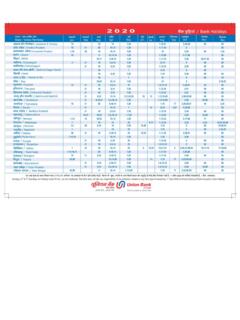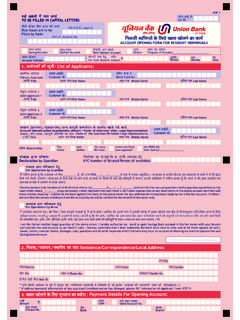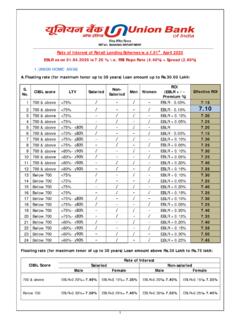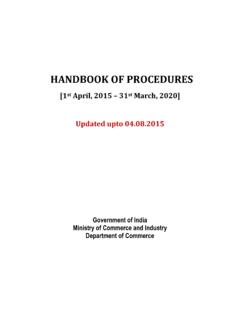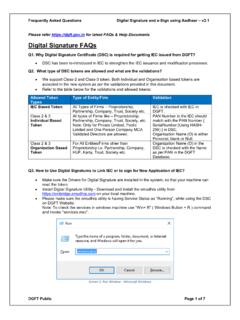Transcription of CHAPTER 19 IMPORTS TRADE/ FEMA GUIDELINES
1 1 CHAPTER 19 IMPORTS TRADE/ FEMA GUIDELINES 2 CHAPTER 19 IMPORTS TRADE / FEMA GUIDELINES INDEX Para No TOPIC Page No 19 1 Introduction 4 19 1 1 Valid Import 4 19 1 2 Importer- exporter Code No.(IEC) 4 19 1 3 Categories of importers 5 19 1 4 Classification of Items 6 19 2 Types of Licences 6 19 2 1 Categories of Licences 6 19 2 2 Some of the Important Features/ Conditions of Licences 6 19 2 3 Licences are Always For CIF Value 10 19 2 4 Transferability of Licences 10 19 2 5 Getting Familiar with various Licence issued under Export Promotion Schemes 10 19 3 1 Time Limit for Settlement of Import Payments 15 19 3 2 Interest on Import Bills 15 19 3 3 Advance Remittance 15 19 3 4 Letter of Credit 17 19 3 5 Obligations of the Purchaser of Foreign Exchange for Import 17 19 3 6
2 Manner of payment by Importer 18 19 3 7 FORM-A 1 18 19 3 8 Agency commission to overseas agents 18 19 3 9 Postal IMPORTS 18 19 3 10 Import of Designs and Drawings 19 19 3 11 Import Licences 19 19 3 12 Import by Courier 20 19 3 13 IMPORTS into Bonded Warehouse 20 19 3 14 Goods Short Supplied / Damage or Lost t 21 19 3 15 Evidence of Import 21 19 3 16 Handling Import Documents on Collection 24 3 19 3 17 Import of Foreign Exchange 24 19 3 18 Import From Nepal & Bhutan 24 19 3 19 Method of payment For Import 24 19 3 20 Attestation of Invoices by Authorised Dealers 26 19 3 21 Remittances towards War Risk Insurance Premium 26 19 3 22 IMPORTS Financed in Rupees 26 19 3 23 IMPORTS under Penalty 26 19 3 24 IMPORTS of Gold, Silver and Jewellery 26 19 3 25 Merchanting Trade 27 19 3 26 IMPORTS under Foreign Loans /Credit arranged by Govt.
3 Of India from Foreign Government / Institution 27 19 3 27 Import of Software through Datacom Channels / Internet 27 19 3 28 Import of Films on Lease / Rental Basis 28 19 3 29 Import Factoring 28 19 3 30 Follow up by Authorised Dealers 28 Annex No Annexure-I BFE 30 4 INTRODUCTION Import is defined as bringing into India any item by sea, land, air or through electronic media. Control over import of goods and services into India is exercised by the Director General of Foreign Trade (DGFT) under the Ministry of Commerce, Government of India. The policy enunciated by this Authority is made available to the public through the Foreign Trade Policy announced from time to time. Earlier the Foreign Trade Policy used to be announced annually.
4 However, , the Govt. Of India came out with Foreign Trade policy valid for 5 years period to afford continuity and stability. The present policy is effective from to subject to the amendments made by means of notifications published in the Gazette of India from time to time. The procedure to be followed in connection with the import is laid down in the 'Hand Book of Procedures'. Any change in the policy or the procedure is informed to the public through 'Public Notices', Amendment Orders' etc. (DIR Series) Circular No. 9 dated of FEMA 1999 published by RBI details the various FEMA Regulations pertaining to release of foreign exchange for import payments. Subsequent amendments are also made through (DIR Series) circulars issued from time to time. Handling of Import business should also be in compliance with FEDAI GUIDELINES , credit norms and internal operational instructions of the Bank.
5 TRADE CONTROL PROVISIONS VALID IMPORT Import is considered as valid if following conditions among others are fulfilled: i) Shipment/ dispatch of the goods from the supplying country takes place within the validity period of the licence/ Customs Clearance Permit. ii) Description, quantity, quality and value should be as per licencing conditions, if the IMPORTS have taken place under licence. The item imported is in accordance with Exim policy as stated in ITC (HS) classification of import items. iii) Compliance of the terms and conditions contained in the licence/ Customs Clearance Permit and the EXIM Policy and Procedures in regard to the item and other connected matters. IMPORTER- exporter CODE NO. (IEC) The importer must possess an 'IMPORTER- exporter CODE NUMBER' allotted by DGFT. Customs Authorities will not allow any person to import or export goods into or from India unless he holds a valid IEC number (unless exempted from obtaining IEC, under provisions of the Exim Policy).
6 (For details, please refer para 2A, CHAPTER 2 of Book of Instructions on Exports) 5 CATEGORIES OF importers : importers are broadly classified as under: i) Actual user importer ii) Stock and sale importer iii) Private importer For purpose of licensing, importers are divided into following broad categories : i) Actual users a) Industrial (AU(I)) b) Non-industrial (AU(NI)) ii) Exporters holding registration cum membership certificate (RCMC) a) Manufacturer Exporters b) Merchant exporter 'Actual User' means an importer who utilises the imported goods for himself, may be industrial or non-industrial Actual user (Industrial) means a person who utilises the imported goods for manufacturing in his own Industrial unit or manufacturing for his own use in another Industrial unit including a jobbing unit. Actual user (Non Industrial) means a person who utilises the imported goods for his own use in : i) any commercial establishment for carrying on any business, trade or profession or ii) any laboratory, scientific or Research and Development Institution or other Educational Institution or iii) any service Industry (includes an Individual, firm, society, Company, Corporation or any other legal person) 'Registration cum membership certificate (RCMC) means a Certificate issued by any Export Promotion Council, Commodity Board or other registering authority designated by Government for the purposes of export promotion.
7 For Export Houses, Trading Houses, Star Trading Houses and Super Star Trading Houses, RCMC will be issued by Federation of Indian Export Organisations (FIEO). 'Manufacturer exporter ' means a person who manufactures goods and exports or intends to export such goods. 'Merchant exporter ' means a person engaged in trading activity and exporting or intending to export such goods. 6 CLASSIFICATION OF ITEMS For the purpose of import, items are classified as 1. Prohibited items - IMPORTS not permitted 2. Restricted Items - Against licence/ as per Public Notice 3. Free items - Freely importable As per the Exim policy 2009-2014, the items are broadly classified into 98 categories laid down in the respective chapters of ITC(HS) classification of Export/ import. The policy/ conditions regarding individual items are laid down against individual items. TYPES OF LICENCES CATEGORIES OF LICENCES Present Exim Policy consists of two types of licences: a) Licences issued for Export Promotion b) Licences issued for Domestic use.
8 A) Licences issued for Export Promotion In this case import licences are granted coupled with export obligation giving concessional rate of duty or exemption from payment of duty to merchant exporters and manufacturer exporters. The purpose of this licence is to enhance competitiveness of export products. The items covered by these licences may be in the "Freely Permissible" category or "Restricted" category. The common licences covered under this category are EPCG Licence, Advance Licence etc. b) Licences issued for Domestic Use In this case, import licence means a licence granted specifically for import of goods which are subject to Import Control. Import Licences are issued by Regional Offices of DGFT or by any officer authorized under the Act or the Rules and Orders made thereunder or under the Policy. Import of goods under a licence granted would be subject to conditions listed in the licence and also the provisions of Export Import Policy of the period in which it is issued.
9 Some of the important features/conditions of licences a) List of items permitted for import: Every licence is valid for import of only specified commodities. Hence, every licence mentions the name or category of goods which can be imported under that licence. This is normally mentioned in the body of licence and/or a separate sheet annexed to the licence. 7 b) Validity of licence: Every licence shall be valid for the period of validity specified in the licence- c) Licensing period: Normally a licence is issued subject to the provisions of Policy applicable as on date of issue of the licence. However to avoid confusion, licence clearly mentions the licensing period (during which it is issued) so that the licence can be operated according to provisions of that particular Policy period. d) Signature of issuing authority: Every licence including the annexures attached to the licence is signed by the issuing authority.
10 Similarly, any additional conditions included or deleted are properly authenticated. e) Security seal: Every licence bears the security seal (similar to postal seal) of the office of issue. This seal is normally affixed above or near the signature of issuing authority. Such seal is also to be affixed on all annexures and at all places of alterations. f) Specific condition of licences: Normally every licence bears conditions of its issuance and import. These conditions may be specified on the licence itself or may be annexed to the licence. When licences are issued against foreign credits, the conditions applicable to the licence is referred to in the body of licence. Every annexure to the licence is referred to in the body of licence and they are signed and sealed by the issuing authorities. All licences must be used/operated subject to such conditions/provisions.



